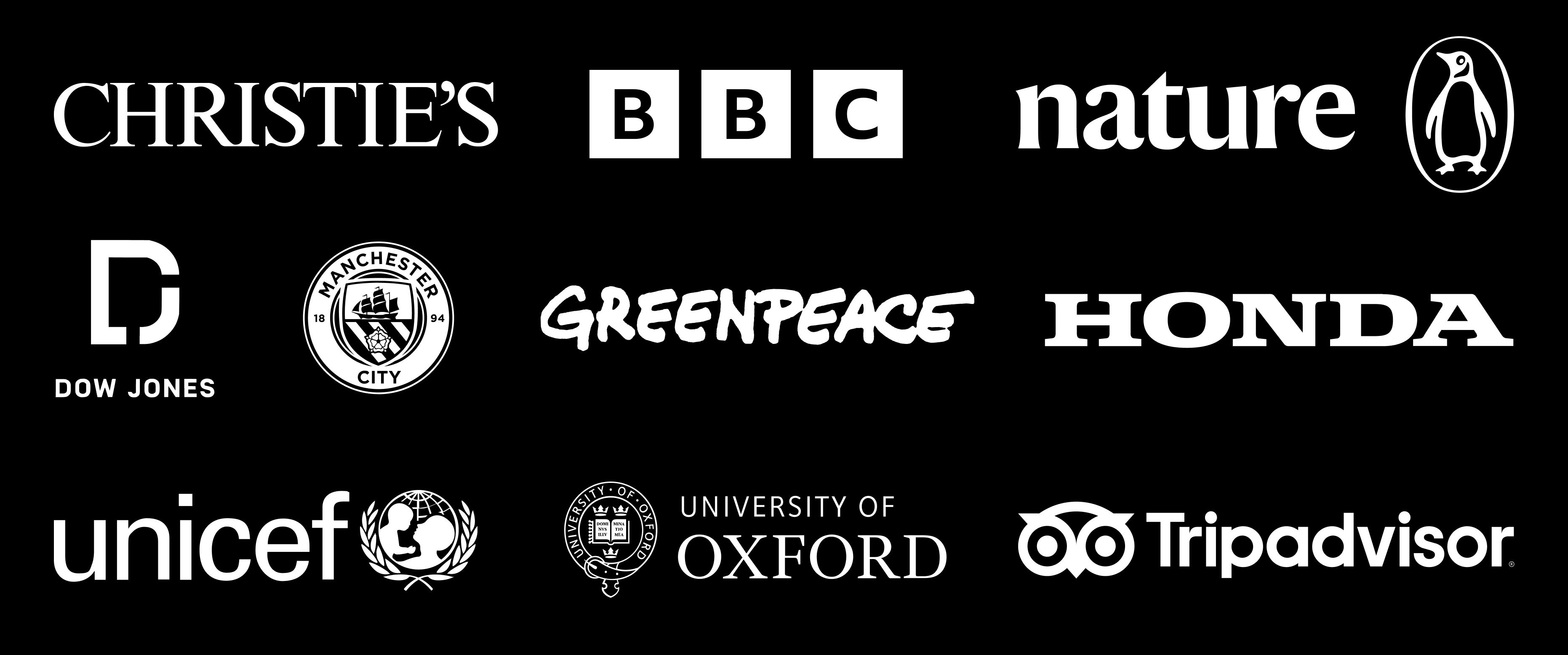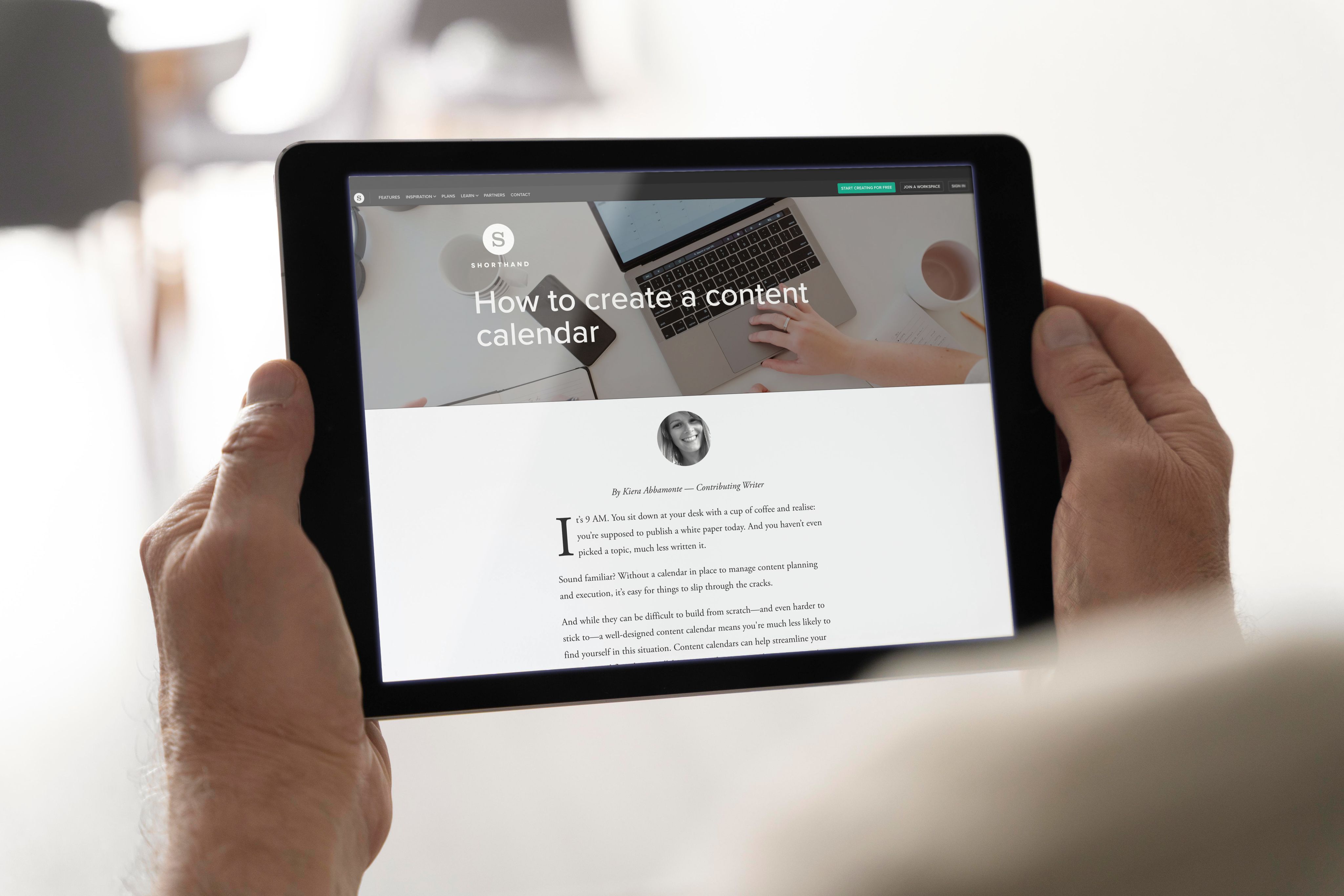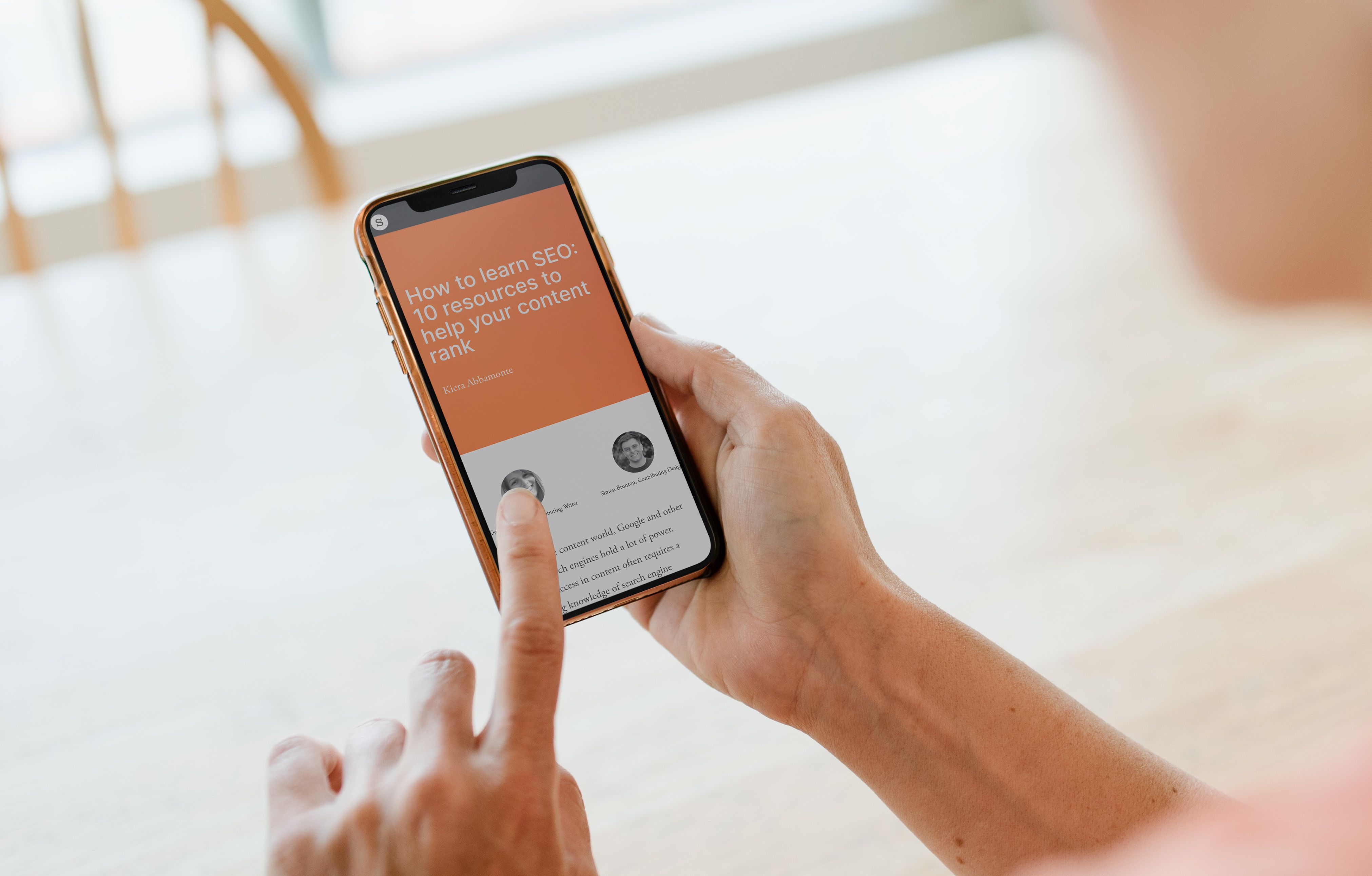15 ways to nail your content distribution strategy

Ever created an amazing piece of content and then… crickets? You’ve poured your heart and soul into a piece you’re sure will go viral but you’re left with no traffic, no sign ups, and certainly no sales. You could be missing a vital piece of the puzzle: content distribution.
by Claire Deane
by Claire Deane
Instead of depending on a build-it-and-they-will-come approach to content marketing, giving distribution as much focus as creation will ensure your audience is finding, consuming, and responding to the content you’ve created.
This article shares some of the most effective ways to distribute your content to help you build momentum from publication and beyond.
We'll cover
Start creating with Shorthand
It's the fastest way to publish beautifully engaging digital content, reports, internal comms, and more.
Loved by the world's most iconic brands
Loved by the world's most iconic brands
What is content distribution?
Content distribution is the process of getting your content in front of your target audience. Content distribution channels are usually categorised into paid, earned, and owned media — we'll break these down in detail, below.
The goal of content distribution is to reach as many people as possible in order to promote a product, service, or message. In order to be effective, content must be well-produced (obviously), targeted to the right audience personas, and distributed through channels that are likely to reach the intended audience. Content distribution can be a challenge, but it is essential for anyone looking to promote their business or message.
Why is content distribution important?
Hubspot says it best: “great content is wasted if your audience doesn’t know it exists”. If you’re creating content, you’ll know that it’s expensive, whether from a time or cost perspective, and it’s important to get the most out of whatever you create. Effective content distribution means you’re sharing a piece of content across multiple channels and moving your customers further down your marketing funnel.
How to develop a content distribution strategy
Your content distribution plan needs to be baked into your content marketing strategy before you start creating a piece of content. Consider these seven tips before you create your content plan, to make sure what you create has been designed with distribution in mind.
Does it meet the ‘Rule of Seven’?
Customers need to hear from you approximately seven times before they’re ready to buy. Can the piece of content you’re creating be leveraged across at least seven different distribution platforms? If not, it might be worth prioritising content that can be spread more widely to get more bang for your buck.
Start with a flagship piece of high-quality content that you can break into multiple smaller pieces of content across multiple channels. For example, one podcast can be turned into many types of content:
- Upload the full video to Youtube, the second largest search engine in the world.
- Cut snippets of audio and video into smaller segments for social media.
- Using templates, pull speaker quotes and turn them into graphics for sharing across your channels.
- Announce your newest episode via email to your marketing database.
- Use the transcript of the audio to create a blog post or case study.
- Schedule re-shares of evergreen content every few months.
- Create assets that you can provide to interviewees for sharing with their own communities. Putting together a social media post or a short blurb that they can include in their newsletter will increase the chances they will actually share what you’ve created.
- Put some ad spend behind key pieces of content on social media.
Hang out at the right parties
Knowing where your audience spends time is vital to great content distribution and where to direct your marketing efforts. There’s plenty of research on the channels people are using. Use this research to guide where you focus your efforts.
Play the field
If your own community is on the smaller side, plan your content to leverage the communities of others in the industry who can boost your distribution. Interview industry leaders, get quotes from businesses that serve the same niche, or just ask your brand friends to help spread the word.
Make the channel work for you
There’s a whole lot more to content distribution than just sharing a link on every channel you can find. Consider how your target audience is consuming content on different channels and design to fit that use case.
For example, on social media, most people won’t actually click a link that will take them off-platform (and the social giants will do anything and everything they can to keep users on-site — including using their algorithm to suppress distribution of content with links). Provide value in the feed that gets people liking, sharing, and commenting without the need to click over to your website.
Make it muscle memory
Consistency is the magic bullet when it comes to content creation. Develop a repeatable process, like a content distribution checklist, that you can follow to ensure you’re getting the most out of your content every time.
Spend more time on distribution than creation
Experts recommend that content creators should be spending 30% of their time on creation, and 70% on distribution. With this in mind, make sure you’re allocating the required resources to content distribution. Odds are, more people are going to see the ‘distribution’ than your original piece of content, so make sure those distribution pieces do the original one justice.
What gets measured, gets managed
It’s important to have targets and key performance indicators (KPIs) around the distribution side of your content process. Having SMART goals will help you determine what’s working and what’s not, so you can refine and improve your process.
15 channels for content distribution

Owned distribution channels
1. Company website
This should be the first place you add your content. Upload your content to your company blog, add links to it from your home page, and make sure it features prominently.
2. Email
Distribute your latest content with your email list. Establish a cadence that works for you and your audience, and stick to it, so customers know what to expect from your email newsletter. While there are many other, shinier distribution channels, email marketing remains one of the most effective forms of engagement.
3. Search engine optimisation (SEO) and AI answer engine optimisation (AEO)
Conduct research into the keywords that your audience are using to find you, and make sure you include these to optimise your content and increase your organic traffic. Organic search can be a key discovery tool for potentials customers, and results can compound over time. Learn more about getting your content to rank here.
4. Email signature
Tools like WiseStamp let you quickly edit your email signature to include a link to your latest piece of content. Consider how many emails you send out a day and how many opportunities this represents for someone to discover your content!
Learn more about owned media with these owned media examples or Brand publishing: your key to a strong online presence.
Earned distribution channels
5. Social media
While this is one of the most obvious channels for content promotion, it’s becoming increasingly difficult to build organic traction. You’ll need to get creative here. Instead of just dropping in a link and calling it a day, take the time to understand what is really working on each channel.
You could try creating different types of content for each channel, around your ‘core’ piece of content. Continuing on with our podcast example, this repurposing could look like super short video snippets, graphics highlighting key quotes, infographics, or a longer, written piece of content highlighting the key lessons learned from the episode — all driving social shares and in-platform engagement.
Not all of this content is designed to drive people directly to your core content piece. People might engage with you on-platform and never actually make it to the podcast. That’s okay though — they’ve still engaged with you on their social networks and you’ve been able to take one core piece of content and turn that into an asset that speaks to that particular user.
Social media platforms prioritise certain content types. Right now, Instagram and Facebook are pushing creators towards reels. Tap into potential virality by creating content using these trending tools.
6. YouTube
We’ve separated this out from social media, because Youtube is also the 2nd largest search engine with approximately 2.6 billion active users globally. Turn your content into video assets — from webinars to other derivative video content — that can be discovered by those searching this channel.
7. Partnerships
Tap into people who have an existing community through interviews, quotes, and brand friendships. Create assets that they can share, including social media images, blurbs that can be included in newsletters, or simply returning the favour and resharing their new content if it’s relevant to your audience.
8. Content platforms
Content platforms like Medium and LinkedIn articles can be used in addition to your blog. These platforms have a built-in audience who visit specifically to read articles and opinions, though invest in these platforms with your eyes wide open, as it can be difficult to achieve traction.
9. Reddit, Quora, and online communities
These communities have strong established rules and it pays to be mindful of them when sharing your content. It’s definitely not the place to drop a backlink and run. Engage honestly and openly with the forum, and share your content when you’re able to use it to solve a real problem for community members.
10. PR / media relations
A great piece of content can also become a great piece of public relations to raise your brand awareness. This is particularly so for content that features research or statistics. If your content is newsworthy, pick out the most interesting angles and turn them into a press release for relevant industry publications.
11. Your team
The employees of your company should be helping with some of the heavy lifting of content distribution and outreach. Especially those in the content team. Be sure to let your team know whenever you publish something new and remind them to share on their own social media channels. LinkedIn allows you to alert team members when a new post goes live, or just drop a reminder in your company Slack. It can help to prepare a short blurb and graphic your team can use, so the only thing they have to do is copy and paste your update to their channel of choice.
12. Groups
Find the communities where your audience are spending time online. Niche Facebook groups are a great place to share content that solves a problem with your audience. Just make sure you read the group rules before posting, as some aren’t keen on self promotion.
Paid distribution channels
13. Advertising
We’d recommend adding advertising to your content strategy and digital marketing once you’ve been able to demonstrate ROI from free channels and know that you’ll be able to amplify that traction with advertising spend. Advertising could include:
- Pay-per-click (PPC) advertising
- Social media advertising, such as Facebook or LinkedIn ads
- Sponsored content
- Display ads
- Native ads
- Retargeting ads
14. Influencers
Influencer marketing isn't just for Instagram. You can work with influencers in your niche to share your content with their audiences. Better yet, interview, quote, or engage with them as part of your content creation process and they’ll be more likely to share your content free of charge.
15. Syndication
Tools like Outbrain let you pay to have your content featured at the bottom of other related articles. This tactic is falling out of favour, but it is a tactic you can experiment with.
Measuring the success of your distribution strategy
One of the most important steps in developing a content distribution strategy is to measure what’s working and what’s not. Look back on your KPIs and their related content marketing metrics, and use Google Analytics to assess your performance. If a piece of content or channel underperforms, consider whether it’s the content, the channel, or a combination of both.
FAQ — Content distribution tactics
How do I prioritise distribution when resources are limited?
If you’re short on time (and who isn’t), don’t spread yourself thin. Pick one or two channels where your audience already pays attention, and commit to doing those well.
A good test is this: if you can’t realistically show up on a channel at least once a week for a month, it’s probably not a priority right now. Consistency matters far more than novelty — something most social and email benchmarks reinforce over time.
How do I decide which content is worth distributing more heavily?
Not every piece deserves the same airtime. Prioritise content that supports a clear business or editorial goal, has a longer shelf life, and shows early signs of organic traction.
If something performs well with minimal promotion, that’s usually a signal it’s worth amplifying. Treat distribution like investing: double down on what’s already proving its value, rather than trying to rescue content that never really landed.
How often should I reshare or repurpose the same content?
More often than most teams are comfortable with — as long as you change the framing.
A practical cadence for evergreen content might look like this:
- Launch week: 2–3 shares per channel, each with a different hook
- Weeks 2–4: reshare weekly with a fresh angle
- Ongoing: re-surface monthly or quarterly if the content is still relevant
If you’re worried about overposting, remember that most platforms show any single post to only a fraction of your audience. Experiments shared by HubSpot suggest that increased posting frequency doesn’t automatically reduce engagement when the content remains useful.
How do I balance organic and paid distribution?
Think of organic distribution as your proof of concept, and paid distribution as the amplifier.
If a piece can’t hold attention organically, paid spend won’t magically fix it — it will just help more people ignore it. Once content performs well on owned channels, paid distribution can extend reach more predictably.
What role does timing really play in content distribution?
Timing matters — just not as much as people think.
Posting when your audience is active helps, but relevance and clarity usually matter more than perfect scheduling. A strong piece shared slightly off-peak will often outperform a weak one shared at the “right” time. Focus on consistent distribution over weeks rather than obsessing over the exact hour you hit publish.
How do I know when a distribution channel isn’t worth the effort?
Decide this before you start, not after you’re emotionally invested.
As a rule of thumb:
- Paid channels should run for at least one full optimisation or learning cycle (often 7–14 days, or longer for low-volume campaigns).
- Organic channels deserve around 30 days of consistent effort.
If performance is still 30–50% worse than your benchmarks and you’ve already tested obvious levers, it’s probably time to pause. Killing underperforming channels is a sign of strategy, not failure — a principle echoed in guidance from platforms like Google Ads.
How does content format affect distribution success?
Some formats are simply easier to distribute than others.
Long-form content often performs best through email, search, and partnerships — places where people are already in “reading mode”. Shorter formats tend to work better on social, where attention is fragmented. Thinking about distribution early helps you choose formats that support your channels, rather than fighting them.
Start creating with Shorthand
It's the fastest way to publish beautifully engaging digital content, reports, internal comms, and more.












